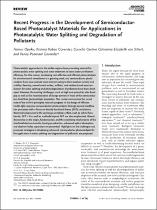 ResearchSpace
ResearchSpace
Recent progress in the development of semiconductor-based photocatalyst materials for applications in photocatalytic water splitting and degradation of pollutants
JavaScript is disabled for your browser. Some features of this site may not work without it.
- ResearchSpace
- →
- Research Publications/Outputs
- →
- Journal Articles
- →
- View Item
| dc.contributor.author |
Opoku, F

|
|
| dc.contributor.author |
Govender, Krishna

|
|
| dc.contributor.author |
Van Sittert, CGCE

|
|
| dc.contributor.author |
Govender, PP

|
|
| dc.date.accessioned | 2017-09-20T09:51:49Z | |
| dc.date.available | 2017-09-20T09:51:49Z | |
| dc.date.issued | 2017-07 | |
| dc.identifier.citation | Opoku, F., Govender, K.K., Van Sittert, C.G.C.E. et al. 2017. Recent progress in the development of semiconductor-based photocatalyst materials for applications in photocatalytic water splitting and degradation of pollutants. Advanced Sustainable Systems, vol. 1(7): DOI: 10.1002/adsu.201700006 | en_US |
| dc.identifier.issn | 2366-7486 | |
| dc.identifier.uri | DOI: 10.1002/adsu.201700006 | |
| dc.identifier.uri | http://onlinelibrary.wiley.com/doi/10.1002/adsu.201700006/full | |
| dc.identifier.uri | http://hdl.handle.net/10204/9584 | |
| dc.description | Advanced Sustainable Systems, vol. 1(7): DOI: 10.1002/adsu.201700006 | en_US |
| dc.description.abstract | Photocatalytic approaches in the visible region show promising potential in photocatalytic water splitting and water treatment to boost water purification efficiency. For this reason, developing cost-effective and efficient photocatalysts for environmental remediation is a growing need, and semiconductor photocatalysts have now received more interest owing to their excellent activity and stability. Recently, several metal oxides, sulfides, and nitrides-based semiconductors for water splitting and photodegradation of pollutants have been developed. However, the existing challenges, such as high over potential, wide band gap as well as fast recombination of charge carriers of most of the semiconductors limit their photocatalytic properties. This review summarizes the recent state-of-the-art first-principles research progress in the design of effective visible-light-response semiconductor photocatalysts through several modification processes with a focus on density functional theory (DFT) calculations. Recent developments to the exchange-correlation effect, such as hybrid functionals, DFT + U as well as methods beyond DFT are also emphasized. Recent discoveries on the origin, fundamentals, and the underlying mechanisms of the interfacial electron transfer, band gap reduction, enhanced optical absorption, and electron–holes separation are presented. Highlights on the challenges and proposed strategies in developing advanced semiconductor photocatalysts for the application in water splitting and degradation of pollutants are proposed. | en_US |
| dc.language.iso | en | en_US |
| dc.publisher | Wiley | en_US |
| dc.relation.ispartofseries | Worklist;19493 | |
| dc.subject | Photocatalytic approaches | en_US |
| dc.subject | Pollutant degradation | en_US |
| dc.subject | Photocatalytic water splitting | en_US |
| dc.title | Recent progress in the development of semiconductor-based photocatalyst materials for applications in photocatalytic water splitting and degradation of pollutants | en_US |
| dc.type | Article | en_US |
| dc.identifier.apacitation | Opoku, F., Govender, K., Van Sittert, C., & Govender, P. (2017). Recent progress in the development of semiconductor-based photocatalyst materials for applications in photocatalytic water splitting and degradation of pollutants. http://hdl.handle.net/10204/9584 | en_ZA |
| dc.identifier.chicagocitation | Opoku, F, Krishna Govender, CGCE Van Sittert, and PP Govender "Recent progress in the development of semiconductor-based photocatalyst materials for applications in photocatalytic water splitting and degradation of pollutants." (2017) http://hdl.handle.net/10204/9584 | en_ZA |
| dc.identifier.vancouvercitation | Opoku F, Govender K, Van Sittert C, Govender P. Recent progress in the development of semiconductor-based photocatalyst materials for applications in photocatalytic water splitting and degradation of pollutants. 2017; http://hdl.handle.net/10204/9584. | en_ZA |
| dc.identifier.ris | TY - Article AU - Opoku, F AU - Govender, Krishna AU - Van Sittert, CGCE AU - Govender, PP AB - Photocatalytic approaches in the visible region show promising potential in photocatalytic water splitting and water treatment to boost water purification efficiency. For this reason, developing cost-effective and efficient photocatalysts for environmental remediation is a growing need, and semiconductor photocatalysts have now received more interest owing to their excellent activity and stability. Recently, several metal oxides, sulfides, and nitrides-based semiconductors for water splitting and photodegradation of pollutants have been developed. However, the existing challenges, such as high over potential, wide band gap as well as fast recombination of charge carriers of most of the semiconductors limit their photocatalytic properties. This review summarizes the recent state-of-the-art first-principles research progress in the design of effective visible-light-response semiconductor photocatalysts through several modification processes with a focus on density functional theory (DFT) calculations. Recent developments to the exchange-correlation effect, such as hybrid functionals, DFT + U as well as methods beyond DFT are also emphasized. Recent discoveries on the origin, fundamentals, and the underlying mechanisms of the interfacial electron transfer, band gap reduction, enhanced optical absorption, and electron–holes separation are presented. Highlights on the challenges and proposed strategies in developing advanced semiconductor photocatalysts for the application in water splitting and degradation of pollutants are proposed. DA - 2017-07 DB - ResearchSpace DP - CSIR KW - Photocatalytic approaches KW - Pollutant degradation KW - Photocatalytic water splitting LK - https://researchspace.csir.co.za PY - 2017 SM - 2366-7486 T1 - Recent progress in the development of semiconductor-based photocatalyst materials for applications in photocatalytic water splitting and degradation of pollutants TI - Recent progress in the development of semiconductor-based photocatalyst materials for applications in photocatalytic water splitting and degradation of pollutants UR - http://hdl.handle.net/10204/9584 ER - | en_ZA |





